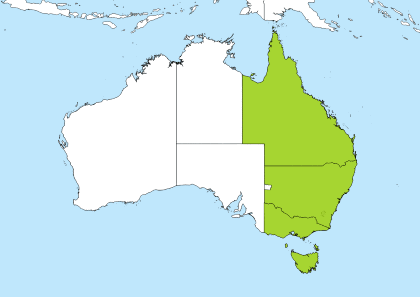PT to AEST Converter
AEST is NOT in use by many locations
AEDT (Australian Eastern Daylight Time) is used instead. Switch to AEDT time zone or select one of the cities Sydney, Melbourne, Gold Coast) for automatic timezone change.Time Difference
Pacific Time is 18 hours behind Australian Eastern Standard Time
10:30 am10:30 in PT is 4:30 am04:30 in AEST
PT to AEST call time
Best time for a conference call or a meeting is between 4am-6am in PT which corresponds to 10pm-12pm in AEST
10:30 am10:30 Pacific Time (PT). Offset UTC -8:00 hours
4:30 am04:30 Australian Eastern Standard Time (AEST). Offset UTC +10:00 hours
10:30 am10:30 PT / 4:30 am04:30 AEST
| PT | AEST |
|---|---|
| 12am (midnight) | 6pm |
| 1am | 7pm |
| 2am | 8pm |
| 3am | 9pm |
| 4am | 10pm |
| 5am | 11pm |
| 6am | 12am (midnight) |
| 7am | 1am |
| 8am | 2am |
| 9am | 3am |
| 10am | 4am |
| 11am | 5am |
| 12pm (noon) | 6am |
| 1pm | 7am |
| 2pm | 8am |
| 3pm | 9am |
| 4pm | 10am |
| 5pm | 11am |
| 6pm | 12pm (noon) |
| 7pm | 1pm |
| 8pm | 2pm |
| 9pm | 3pm |
| 10pm | 4pm |
| 11pm | 5pm |
| 0:00 | 18:00 |
| 1:00 | 19:00 |
| 2:00 | 20:00 |
| 3:00 | 21:00 |
| 4:00 | 22:00 |
| 5:00 | 23:00 |
| 6:00 | 0:00 |
| 7:00 | 1:00 |
| 8:00 | 2:00 |
| 9:00 | 3:00 |
| 10:00 | 4:00 |
| 11:00 | 5:00 |
| 12:00 | 6:00 |
| 13:00 | 7:00 |
| 14:00 | 8:00 |
| 15:00 | 9:00 |
| 16:00 | 10:00 |
| 17:00 | 11:00 |
| 18:00 | 12:00 |
| 19:00 | 13:00 |
| 20:00 | 14:00 |
| 21:00 | 15:00 |
| 22:00 | 16:00 |
| 23:00 | 17:00 |
Pacific Time
Pacific Time (PT) is a general term used to describe the areas that observe either the Pacific Standard Time (PST) or Pacific Daylight Time (PDT) in the United States and Canada. PT also called Pacific Coast Time. PT is not static but switches between PDT and PST.
Territories observing the Pacific Time Zone are primarily in North America. It runs through the western part of Canada, the United States and the Northwestern part of Mexico.
Countries: It is used in following countries: Canada, Mexico, United States.
Principal Cities: The largest city in the PST timezone is Los Angeles from USA with population about 3.793 million people. Other major cities in the area are Vancouver, Tijuana, San Diego, San Jose.
French: HNP - Heure Normale du Pacifique
Spanish: PT - Tiempo del Pacífico, PT - Zona Noroeste
Pacific Time (PT) is a general term used to describe the areas that observe either the Pacific Standard Time (PST) or Pacific Daylight Time (PDT) in the United States and Canada. PT also called Pacific Coast Time. PT is not static but switches between PDT and PST.
Territories observing the Pacific Time Zone are primarily in North America. It runs through the western part of Canada, the United States and the Northwestern part of Mexico.
Countries: It is used in following countries: Canada, Mexico, United States.
Principal Cities: The largest city in the PST timezone is Los Angeles from USA with population about 3.793 million people. Other major cities in the area are Vancouver, Tijuana, San Diego, San Jose.
French: HNP - Heure Normale du Pacifique
Spanish: PT - Tiempo del Pacífico, PT - Zona Noroeste
PT representations, usage and related time zones
- -08 - basic short
- -0800 - basic
- -08:00 - extended
- -0800 - sign character (-) followed by a four digit time providing hours (08) and minutes (00) of the offset. Indicates eight hour and zero minutes time differences to the west of the zero meridian.
- Uniform - Military abbreviation for PT
- U - short form of 'Uniform'
- Pacific Time - UTC -8
- Palau Time - UTC +9
- AKDT - Alaska Daylight Time
- PST - Pacific Standard Time
- PT - Pacific Time
- PST - Pitcairn Standard Time
- U - Uniform Time Zone
Australian Eastern Standard Time
Offset: AEST is 10 hours ahead Greenwich Mean Time (GMT) and is used in Australia
Countries: It is used in following countries: Australia
Principal Cities: The largest city in the AEST timezone is Sydney from Australia with population about 4.627 million people. Other major cities in the area are Melbourne, Brisbane, Gold Coast, Canberra

Daylight Saving: This is a standard time zone, however during summer some places switch clocks for one hour forward when daylight saving comes into effect and observe Australian Eastern Daylight Time (AEDT).
 End: Australian Eastern Standard Time (AEST) has ended on Sunday, October 5, 2025 at 2:00 am local time and clocks were set one hour forward to Sunday, October 5, 2025, 3:00 am local daylight time instead. Standard time ends annually the on first Sunday of October.
End: Australian Eastern Standard Time (AEST) has ended on Sunday, October 5, 2025 at 2:00 am local time and clocks were set one hour forward to Sunday, October 5, 2025, 3:00 am local daylight time instead. Standard time ends annually the on first Sunday of October.
 Start: Australian Eastern Standard Time (AEST) starts on Sunday, April 5, 2026 at 3:00 am local time and clocks are set one hour back to Sunday, April 5, 2026, 2:00 am. Standard time starts annually the on first Sunday of April.
Start: Australian Eastern Standard Time (AEST) starts on Sunday, April 5, 2026 at 3:00 am local time and clocks are set one hour back to Sunday, April 5, 2026, 2:00 am. Standard time starts annually the on first Sunday of April.
Australian Eastern Standard Time (AEST) is used in Queensland, Victoria, Tasmania, New South Wales (except Broken Hill), Australian Capital Territory and in folling major cities Brisbane, Sydney, Melbourne, Hobart, Canberra
Only part of Australia observe daylight saving. It is used in New South Wales, Victoria, South Australia, Tasmania, and the Australian Capital Territory. Daylight saving is not observed in Queensland, Western Australia or the Northern Territory.
AEST representations, usage and related time zones
- +10 - basic short
- +1000 - basic
- +10:00 - extended
- +1000 - sign character (+) followed by a four digit time providing hours (10) and minutes (00) of the offset. Indicates ten hour and zero minutes time differences to the east of the zero meridian.
- Kilo - Military abbreviation for AEST
- K - short form of 'Kilo'
- Antarctica/Macquarie
- Australia/ACT
- Australia/Brisbane
- Australia/Canberra
- Australia/Currie
- Australia/Hobart
- Australia/Lindeman
- Australia/Melbourne
- Australia/NSW
- Australia/Queensland
- Australia/Sydney
- Australia/Tasmania
- Australia/Victoria
- AEST - Australian Eastern Standard Time
- CHUT - Chuuk Time
- ChST - Chamorro Standard Time
- K - Kilo Time Zone
- KDT - Korea Daylight Time
- PGT - Papua New Guinea Time
- VLAT - Vladivostok Time
- YAKST - Yakutsk Summer Time
- YAPT - Yap Time
